The harmonic interval (iA)
The Harmonic interval is a distance element that measures the vertical distance between 2 different Notes sounding at the same time. If we understand each voice as a curve, at each time point or Pulse there is a distance or Harmonic interval (iA) between the Notes of each voice.
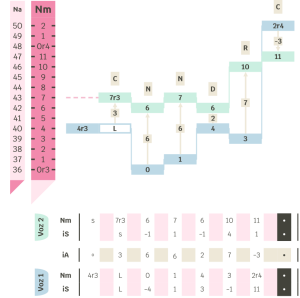
- The calculation of the iA
- The concretion of the iA
- The sonority of the iAs
- Complementarity and mirror iA
- The sets of iAs
To calculate the iA between 2 voices we use the following formula:
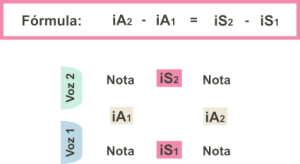 |
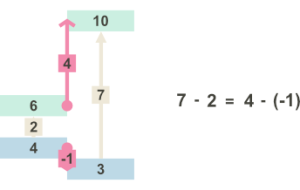 |
| Example of application of the formula |
From this formula, we can isolate and deduce each of the four variables:
| iA1 = iA2 – (iS2 – iS1)
iA2= iA1 + (iS2 – iS1) |
iS1 = iS2 – (iA2 – iA1)
iS2 = iS1 + (iA2 – iA1) |
The iA can be expressed in absolute and modular numbering. In the same way as in the concretion of the iS, if an iA is expressed in modular numbering (iAm) but its register does not appear, as for example iAm (1), we still do not know its exact distance, since all registers are possible. Thus the distance of iAm (1) could be specified as iAm (1r0), iAm (1r1), iAm (1r2), etc. Remember that an iA expressed in absolute numbering (iAa) is already an exact distance that does not need to be specified.
If an iA does not have its sign specified, we do not yet know its direction and placement of its voices (either voice 2 above, or voice 1 above) and both options are possible. If we want voice 2 to be above voice 1, we do not add a sign; and if a crossover has occurred and voice 2 is below voice 1, we add a – sign. For example, the direction of iA (7), could be specified as iA (-7), or iA (7):
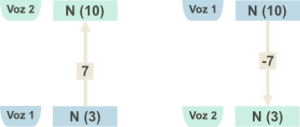
Finally, since the iA is a distance element it can be used from any note.
Each iA has a sonority that gives it a personality. We classify the different sonorities according to the harmonic series and the order in which each iA appears:
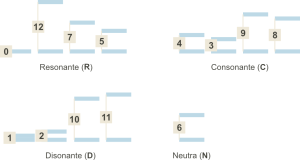
This classification of the different sonorities of the iAs is subjective, so other classifications are also possible, such as according to their brightness/darkness, etc.
The complementary iA’s share the same sonority. Two iA are complementary if they add up to 12, which is the module of the collection of chromatic notes:
![]()
*iA (6) has no complementary.
The iA mirror (iAe)
In mirror iA (iAe), the module is reduced to 6: there will only be mirror iA from 1 to 6. To express as iA mirror the rest of iA (7, 8, 9, 9, 10, and 11), we use the complementarity feature:
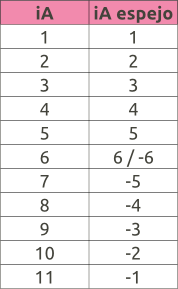 |
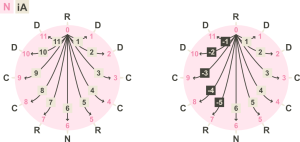 |
| Table | The sonorities in the iA and mirror iA are equivalent |
As with any element, different sets can be made with the iAs: collections, horizontal successions where a progression of iAs is established and we have to take into account the simultaneous movements between the voices of two superimposed melodies, and vertical successions which we call chords.
The result of the combination of iA is much more than the mere sum of the two melodies(polyphony); it is like a melody of sonorities that introduces us to the world of harmony.

